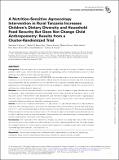| dc.description.abstract | Background
There are urgent calls for the transformation of agriculture and food systems to address human and planetary health issues. Nutrition-sensitive agriculture and agroecology promise interconnected solutions to these challenges, but evidence of their impact has been limited.
Objectives
In a cluster-randomized trial (NCT02761876), we examined whether a nutrition-sensitive agroecology intervention in rural Tanzania could improve children's dietary diversity. Secondary outcomes were food insecurity and child anthropometry. We also posited that such an intervention would improve sustainable agricultural practices (e.g., agrobiodiversity, intercropping), women's empowerment (e.g., participation in decision making, time use), and women's well-being (e.g., dietary diversity, depression).
Methods
Food-insecure smallholder farmers with children aged <1 y from 20 villages in Singida, Tanzania, were invited to participate. Villages were paired and publicly randomized; control villages received the intervention after 2 y. One man and 1 woman “mentor farmer” were elected from each intervention village to lead their peers in agroecological learning on topics including legume intensification, nutrition, and women's empowerment. Impact was estimated using longitudinal difference-in-differences fixed-effects regression analyses.
Results
A total of 591 households (intervention: n = 296; control: n = 295) were enrolled; 90.0% were retained to study end. After 2 growing seasons, the intervention improved children's dietary diversity score by 0.57 food groups (out of 7; P < 0.01), and the percentage of children achieving minimum dietary diversity (≥4 food groups) increased by 9.9 percentage points during the postharvest season. The intervention significantly reduced household food insecurity but had no significant impact on child anthropometry. The intervention also improved a range of sustainable agriculture, women's empowerment, and women's well-being outcomes.
Conclusions
The magnitude of the intervention's impacts was similar to or larger than that of other nutrition-sensitive interventions that provided more substantial inputs but were not agroecologically focused. These data suggest the untapped potential for nutrition-sensitive agroecological approaches to achieve human health while promoting sustainable agricultural practices. | en_US |

